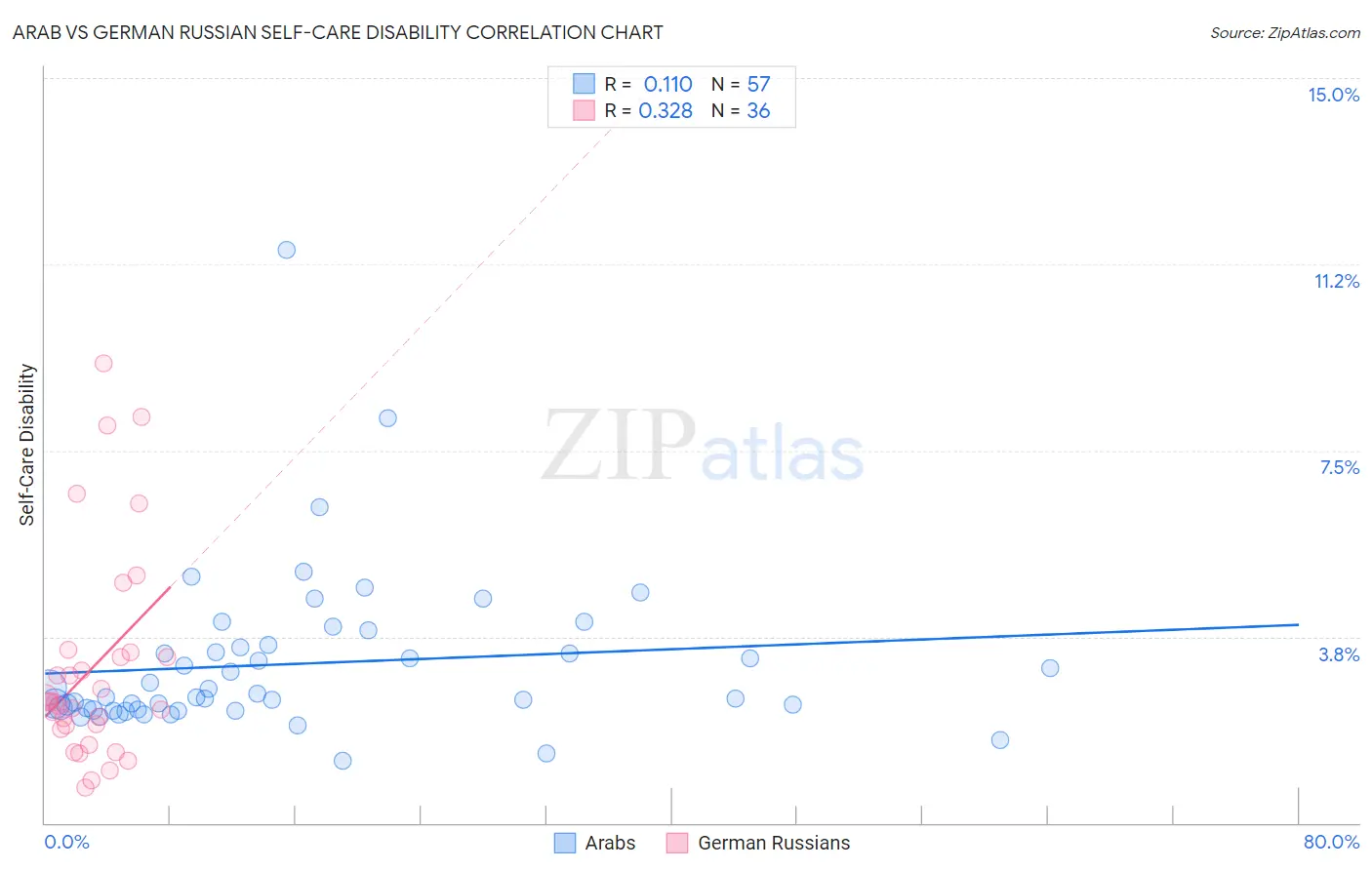Arab vs German Russian Self-Care Disability
COMPARE
Arab
German Russian
Self-Care Disability
Self-Care Disability Comparison
Arabs
German Russians
2.4%
SELF-CARE DISABILITY
75.7/ 100
METRIC RATING
149th/ 347
METRIC RANK
2.5%
SELF-CARE DISABILITY
62.7/ 100
METRIC RATING
163rd/ 347
METRIC RANK
Arab vs German Russian Self-Care Disability Correlation Chart
The statistical analysis conducted on geographies consisting of 485,999,863 people shows a poor positive correlation between the proportion of Arabs and percentage of population with self-care disability in the United States with a correlation coefficient (R) of 0.110 and weighted average of 2.4%. Similarly, the statistical analysis conducted on geographies consisting of 96,413,483 people shows a mild positive correlation between the proportion of German Russians and percentage of population with self-care disability in the United States with a correlation coefficient (R) of 0.328 and weighted average of 2.5%, a difference of 0.75%.

Self-Care Disability Correlation Summary
| Measurement | Arab | German Russian |
| Minimum | 1.3% | 0.71% |
| Maximum | 11.5% | 9.3% |
| Range | 10.3% | 8.5% |
| Mean | 3.2% | 3.1% |
| Median | 2.5% | 2.4% |
| Interquartile 25% (IQ1) | 2.3% | 1.9% |
| Interquartile 75% (IQ3) | 3.6% | 3.4% |
| Interquartile Range (IQR) | 1.3% | 1.5% |
| Standard Deviation (Sample) | 1.6% | 2.1% |
| Standard Deviation (Population) | 1.6% | 2.1% |
Demographics Similar to Arabs and German Russians by Self-Care Disability
In terms of self-care disability, the demographic groups most similar to Arabs are Romanian (2.4%, a difference of 0.010%), Immigrants from Costa Rica (2.4%, a difference of 0.040%), Basque (2.4%, a difference of 0.11%), Dutch (2.4%, a difference of 0.12%), and Tlingit-Haida (2.4%, a difference of 0.14%). Similarly, the demographic groups most similar to German Russians are Somali (2.5%, a difference of 0.050%), Immigrants from Vietnam (2.5%, a difference of 0.17%), Syrian (2.5%, a difference of 0.19%), Lebanese (2.4%, a difference of 0.20%), and Canadian (2.5%, a difference of 0.20%).
| Demographics | Rating | Rank | Self-Care Disability |
| Israelis | 80.0 /100 | #146 | Good 2.4% |
| Dutch | 77.5 /100 | #147 | Good 2.4% |
| Romanians | 75.8 /100 | #148 | Good 2.4% |
| Arabs | 75.7 /100 | #149 | Good 2.4% |
| Immigrants | Costa Rica | 75.1 /100 | #150 | Good 2.4% |
| Basques | 74.0 /100 | #151 | Good 2.4% |
| Tlingit-Haida | 73.5 /100 | #152 | Good 2.4% |
| Immigrants | England | 73.5 /100 | #153 | Good 2.4% |
| Italians | 72.2 /100 | #154 | Good 2.4% |
| Pakistanis | 71.4 /100 | #155 | Good 2.4% |
| Nigerians | 70.6 /100 | #156 | Good 2.4% |
| Immigrants | Europe | 69.6 /100 | #157 | Good 2.4% |
| Immigrants | Western Europe | 68.6 /100 | #158 | Good 2.4% |
| Immigrants | Italy | 68.5 /100 | #159 | Good 2.4% |
| Finns | 67.0 /100 | #160 | Good 2.4% |
| Lebanese | 66.5 /100 | #161 | Good 2.4% |
| Somalis | 63.7 /100 | #162 | Good 2.5% |
| German Russians | 62.7 /100 | #163 | Good 2.5% |
| Immigrants | Vietnam | 59.3 /100 | #164 | Average 2.5% |
| Syrians | 59.0 /100 | #165 | Average 2.5% |
| Canadians | 58.8 /100 | #166 | Average 2.5% |